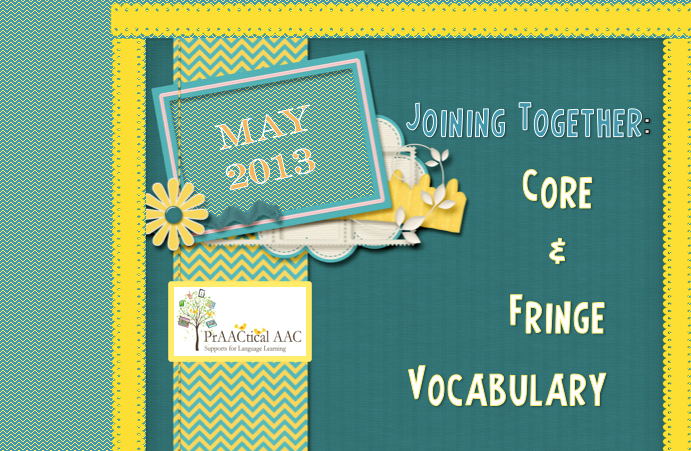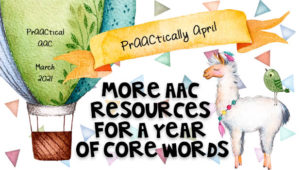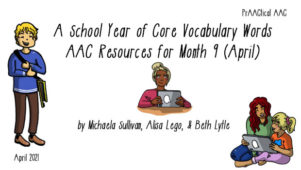Join Together Core & Fringe Vocabulary

Last month we talked about Core Words, and we shared core word samples, philosophies, and resources. As we have moved into May’s Strategy of the Month, Communication Boards, we now want to share ideas about joining core and fringe words together on communication boards.
Core vocabulary are those words used with high frequency and make up about 75-80% of the words we use everyday. Core vocabulary should be a main part of all AAC systems because it allows for most flexibility across most situations.
With an emphasis on core words, we also use Fringe Vocabulary 20-25% of the time. Fringe vocabulary are used in a continuum of low-frequency to lower frequency situations (e.g., ‘mountain’: ‘glacier’, ‘crevasse’). Personal vocabulary can also be included under fringe vocabulary and would relate to personal words someone might need for their individual needs, interests, work, school, or even community.
So, in the best communication world, AAC users would have access to core and fringe vocabulary so that they have maximum communication power no matter where they are, who they are with, or what they are doing.
Now the more complicated part, how do we get all of that ‘power’ onto a communication board. As with anything complicated, there are a variety of philosophy considerations, teaching strategies, questions to ask, and ways to do it. Here we go:
Some Philosophical Considerations
Communication boards should:
-
Have emphasis on core vocabulary- Core vocabulary needs to be emphasized in individual communication systems. Core words are the most flexible and can meet someone’s communication needs most of the time.
-
Have inclusion of fringe vocabulary- Fringe vocabulary is also important and should join core vocabulary for a more total or comprehensive communication system.
-
Keep core vocabulary in static positions- A principle of core vocabulary learning is that the words stay in a consistent position across communication tools and even when new words are added (long-term planning is important here know where the first 100 words will go, even if you are starting with 12).
-
Add fringe vocabulary in a static organizational/placement system- Create a core to fringe word systematic layout, so AAC users (and facilitators) know where to locate the consistent core words and know where the framework for the fringe vocabulary will be located.
Remember:
-
Core vocabulary needs to be taught- Use core vocabulary teaching strategies. These words are often abstract and might be harder to learn than more concrete ones and therefore need many, many communication opportunities for the learner to prAACtice using them in authentic situations.
-
With core word vocabulary communication boards, ‘Ease of Use’ at first is not predictor of success- Teaching, prAACtice, teaching, more prAACtice (maybe even more teaching and prAACtice) is necessary when learning a new communication system. Make sure true teaching and prAACtice happens before testing and making a decision as to whether or not an AAC learner can be successful. Think of it like learning a new language, most anyone would need more than a 6 week trial period before losing the opportunity to be allowed to speak that new language. Keep in perspective, in the teaching/learning process is the AAC user truly immersed in AAC language. Do people speak AAC to the AAC learner all the time?, are there opportunities for them to prAACtice speaking back (even if their response is not perfect?), and do they have access to a full range of that language at all times? The answers to all of these questions do not have to be ‘yes’, but i if not yes then the ‘no’s’ need to considered when deciding the level of learning and communication success.
-
Create many communication opportunities– Make sure there are many opportunities to USE the communication system for a variety of communication functions/reasons: requesting, commenting, protesting, chatting, conversation, and more.
- Use Aided Language Input (ALI) and other specific teaching strategies- Can not be said enough, Use AAC to model AAC language.
-
Provide specific feedback to AAC communication and respect good.
Ways To Do It: 5 Ideas
-
Single page communication board with core vocabulary on one side and fringe vocabulary on the other.- With this framework for your communication board, a consistent set of core vocabulary would always be on the left side and a set of fringe vocabulary would be on the right side. The core vocabulary would stay constant, but the fringe vocabulary would change based on the context. This would mean that the AAC user would have a predictable way of knowing where vocabulary was located. Check out the impact of a system like this at: A Few Good Words by Barbara Cannon & Grace Edmond.
-
Single page communication board with core words with attached flip page set of fringe vocabulary
 – Within this framework, core words are static on a communication board but there are a variety of tabbed pages that flip based on the fringe vocabulary needed. The core words are always available (able to be seen and accessed). The Pixon™ Project Kit is an example of this type of communication board arrangement (and much more).
– Within this framework, core words are static on a communication board but there are a variety of tabbed pages that flip based on the fringe vocabulary needed. The core words are always available (able to be seen and accessed). The Pixon™ Project Kit is an example of this type of communication board arrangement (and much more). -
Single page communication board with core words with attached side velcro or magnetic fringe vocabulary- Within this framework, the core vocabulary is in the center of a communication board and the fringe vocabulary attaches around the sides, bottom, and/or top, but the core center remains constant. The fringe vocabulary can be changed easily depending upon the context of communication.
- Tri-fold communication books- A tri-fold communication book can have the core vocabulary in the center available at all times and fringe vocabulary ‘flips out’ or opens from the sides and bottom to reveal fringe vocabulary. In this example, the specific fringe vocabulary stays fairly constant but covers a range of needs. A sample of a tri-fold communication board was developed from the AT Team at Orange County Public Schools (Florida)
-
Individual communication boards with core words and group or activity area boards with fringe vocabulary- In this framework, each AAC user would have their own core word communication board that goes with them where ever they go. The environment or area would have a group communication board that has the fringe vocabulary relating to the environment or context. An example of this could be, science lab. The learner has a core communication board but once in the science lab, the fringe vocabulary to talk and learn specific ‘science’ is at the lab station on chemical reactions.
We would love to see any pictures of core and fringe communication boards that you have used.
Filed under: Strategy of the Month
Tagged With: communication boards, core vocabulary, fringe vocabulary
This post was written by Robin Parker







4 Comments
Great Pot. i would like to see examples of setting up something on the ipad (i use Go talk now) how to set up core correctly in the beginning. Then how to move to the fringe, with either swiping the pad or…???
Thanks you!
Liz, there are a growing number of AAC apps that are geared toward core vocabulary and, of course, have great capacity for extended vocabulary, too. Speak For Yourself, Touch Chat with WordPower, AACORN, and Proloquo come to mind. They all have different ways of addressing core words and you can pick the one most appropriate for your client’s needs. Thanks for stopping by!
Great post! Where would I find the materials for option #2? I’ve looked into the Flip n’ Talk, but wondered if there was a better (or cheaper) option. Thanks!
Lauren, are you on the Boardmaker Online site? There are a number of them there. I think we’ve posted some to the PrAACtical AAC Facebook page. Have a look and reach out to me there if you cannot find the kind you are looking for. 🙂